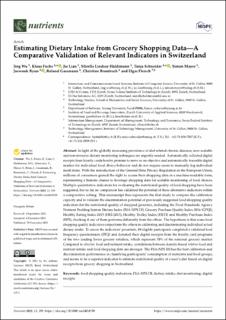Please use this identifier to cite or link to this item:
https://doi.org/10.21256/zhaw-23856Full metadata record
| DC Field | Value | Language |
|---|---|---|
| dc.contributor.author | Wu, Jing | - |
| dc.contributor.author | Fuchs, Klaus | - |
| dc.contributor.author | Lian, Jie | - |
| dc.contributor.author | Haldimann, Mirella Lindsay | - |
| dc.contributor.author | Schneider, Tanja | - |
| dc.contributor.author | Mayer, Simon | - |
| dc.contributor.author | Byun, Jaewook | - |
| dc.contributor.author | Gassmann, Roland | - |
| dc.contributor.author | Brombach, Christine | - |
| dc.contributor.author | Fleisch, Elgar | - |
| dc.date.accessioned | 2022-01-07T13:01:41Z | - |
| dc.date.available | 2022-01-07T13:01:41Z | - |
| dc.date.issued | 2021-12 | - |
| dc.identifier.issn | 2072-6643 | de_CH |
| dc.identifier.uri | https://digitalcollection.zhaw.ch/handle/11475/23856 | - |
| dc.description.abstract | In light of the globally increasing prevalence of diet-related chronic diseases, new scalable and non-invasive dietary monitoring techniques are urgently needed. Automatically collected digital receipts from loyalty cards hereby promise to serve as an objective and automatically traceable digital marker for individual food choice behavior and do not require users to manually log individual meal items. With the introduction of the General Data Privacy Regulation in the European Union, millions of consumers gained the right to access their shopping data in a machine-readable form, representing a historic chance to leverage shopping data for scalable monitoring of food choices. Multiple quantitative indicators for evaluating the nutritional quality of food shopping have been suggested, but so far, no comparison has validated the potential of these alternative indicators within a comparative setting. This manuscript thus represents the first study to compare the calibration capacity and to validate the discrimination potential of previously suggested food shopping quality indicators for the nutritional quality of shopped groceries, including the Food Standards Agency Nutrient Profiling System Dietary Index (FSA-NPS DI), Grocery Purchase Quality Index-2016 (GPQI), Healthy Eating Index-2015 (HEI-2015), Healthy Trolley Index (HETI) and Healthy Purchase Index (HPI), checking if any of them performs differently from the others. The hypothesis is that some food shopping quality indicators outperform the others in calibrating and discriminating individual actual dietary intake. To assess the indicators’ potentials, 89 eligible participants completed a validated food frequency questionnaire (FFQ) and donated their digital receipts from the loyalty card programs of the two leading Swiss grocery retailers, which represent 70% of the national grocery market. Compared to absolute food and nutrient intake, correlations between density based relative food and nutrient intake and food shopping data are stronger. The FSA-NPS DI has the best calibration and discrimination performance in classifying participants’ consumption of nutrients and food groups, and seems to be a superior indicator to estimate nutritional quality of a user’s diet based on digital receipts from grocery shopping in Switzerland. | de_CH |
| dc.language.iso | en | de_CH |
| dc.publisher | MDPI | de_CH |
| dc.relation.ispartof | Nutrients | de_CH |
| dc.rights | http://creativecommons.org/licenses/by/4.0/ | de_CH |
| dc.subject | Food shopping quality indicator | de_CH |
| dc.subject | FSA-NPS DI | de_CH |
| dc.subject | Dietary intake | de_CH |
| dc.subject | Diet monitoring | de_CH |
| dc.subject | Digital receipt | de_CH |
| dc.subject.ddc | 613.2: Diätetik | de_CH |
| dc.title | Estimating dietary intake from grocery shopping data – a comparative validation of relevant indicators in Switzerland | de_CH |
| dc.type | Beitrag in wissenschaftlicher Zeitschrift | de_CH |
| dcterms.type | Text | de_CH |
| zhaw.departement | Life Sciences und Facility Management | de_CH |
| zhaw.organisationalunit | Institut für Lebensmittel- und Getränkeinnovation (ILGI) | de_CH |
| dc.identifier.doi | 10.3390/nu14010159 | de_CH |
| dc.identifier.doi | 10.21256/zhaw-23856 | - |
| zhaw.funding.eu | No | de_CH |
| zhaw.issue | 1 | de_CH |
| zhaw.originated.zhaw | Yes | de_CH |
| zhaw.pages.start | 159 | de_CH |
| zhaw.publication.status | publishedVersion | de_CH |
| zhaw.volume | 14 | de_CH |
| zhaw.publication.review | Peer review (Publikation) | de_CH |
| zhaw.funding.snf | 188402 | de_CH |
| zhaw.webfeed | Ernährung | de_CH |
| zhaw.author.additional | No | de_CH |
| zhaw.display.portrait | Yes | de_CH |
| Appears in collections: | Publikationen Life Sciences und Facility Management | |
Files in This Item:
| File | Description | Size | Format | |
|---|---|---|---|---|
| 2021_Wu-etal_Dietary-intake-estimation-grocery-shopping-data.pdf | 1.3 MB | Adobe PDF |  View/Open |
Show simple item record
Wu, J., Fuchs, K., Lian, J., Haldimann, M. L., Schneider, T., Mayer, S., Byun, J., Gassmann, R., Brombach, C., & Fleisch, E. (2021). Estimating dietary intake from grocery shopping data – a comparative validation of relevant indicators in Switzerland. Nutrients, 14(1), 159. https://doi.org/10.3390/nu14010159
Wu, J. et al. (2021) ‘Estimating dietary intake from grocery shopping data – a comparative validation of relevant indicators in Switzerland’, Nutrients, 14(1), p. 159. Available at: https://doi.org/10.3390/nu14010159.
J. Wu et al., “Estimating dietary intake from grocery shopping data – a comparative validation of relevant indicators in Switzerland,” Nutrients, vol. 14, no. 1, p. 159, Dec. 2021, doi: 10.3390/nu14010159.
WU, Jing, Klaus FUCHS, Jie LIAN, Mirella Lindsay HALDIMANN, Tanja SCHNEIDER, Simon MAYER, Jaewook BYUN, Roland GASSMANN, Christine BROMBACH und Elgar FLEISCH, 2021. Estimating dietary intake from grocery shopping data – a comparative validation of relevant indicators in Switzerland. Nutrients. Dezember 2021. Bd. 14, Nr. 1, S. 159. DOI 10.3390/nu14010159
Wu, Jing, Klaus Fuchs, Jie Lian, Mirella Lindsay Haldimann, Tanja Schneider, Simon Mayer, Jaewook Byun, Roland Gassmann, Christine Brombach, and Elgar Fleisch. 2021. “Estimating Dietary Intake from Grocery Shopping Data – a Comparative Validation of Relevant Indicators in Switzerland.” Nutrients 14 (1): 159. https://doi.org/10.3390/nu14010159.
Wu, Jing, et al. “Estimating Dietary Intake from Grocery Shopping Data – a Comparative Validation of Relevant Indicators in Switzerland.” Nutrients, vol. 14, no. 1, Dec. 2021, p. 159, https://doi.org/10.3390/nu14010159.
Items in DSpace are protected by copyright, with all rights reserved, unless otherwise indicated.